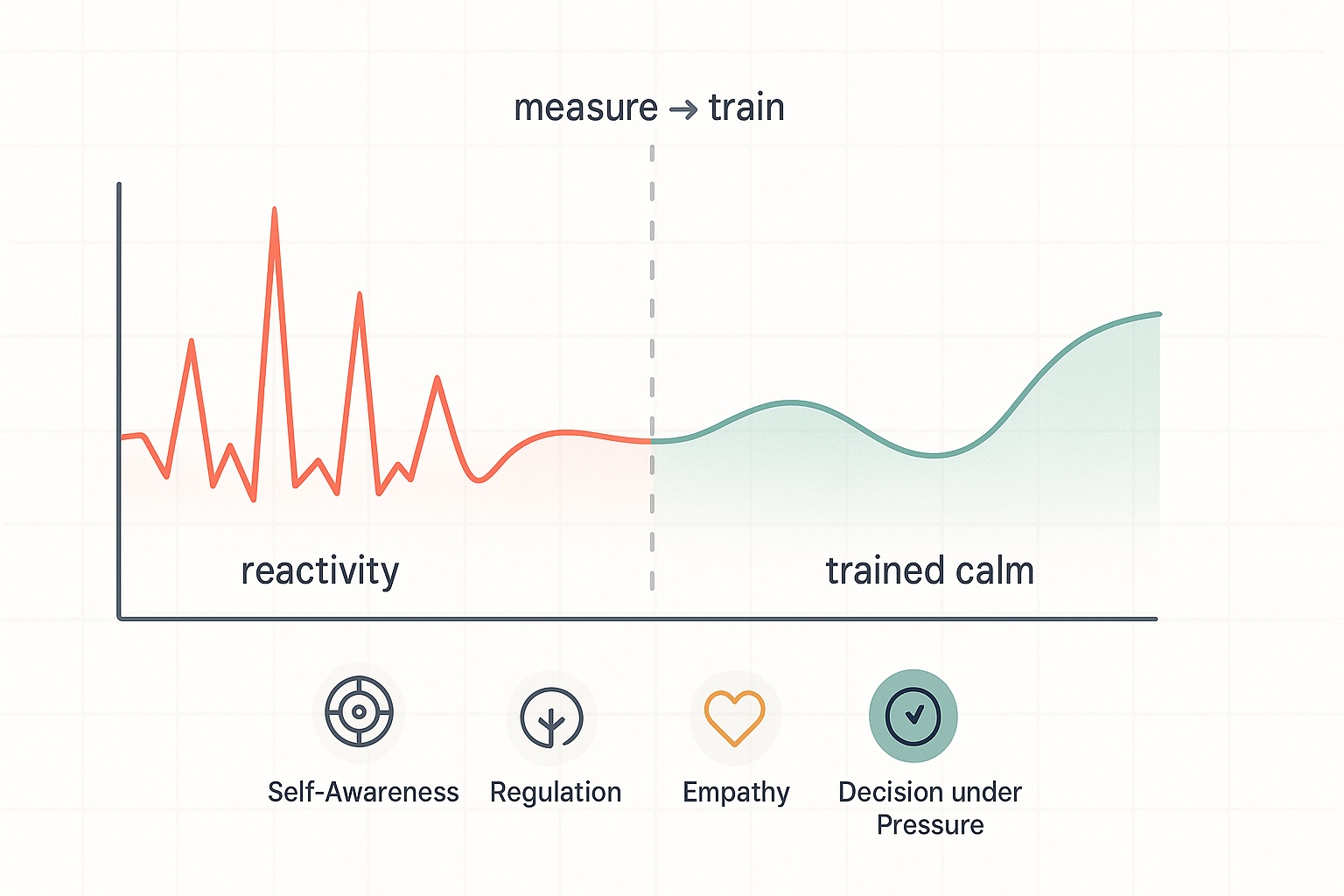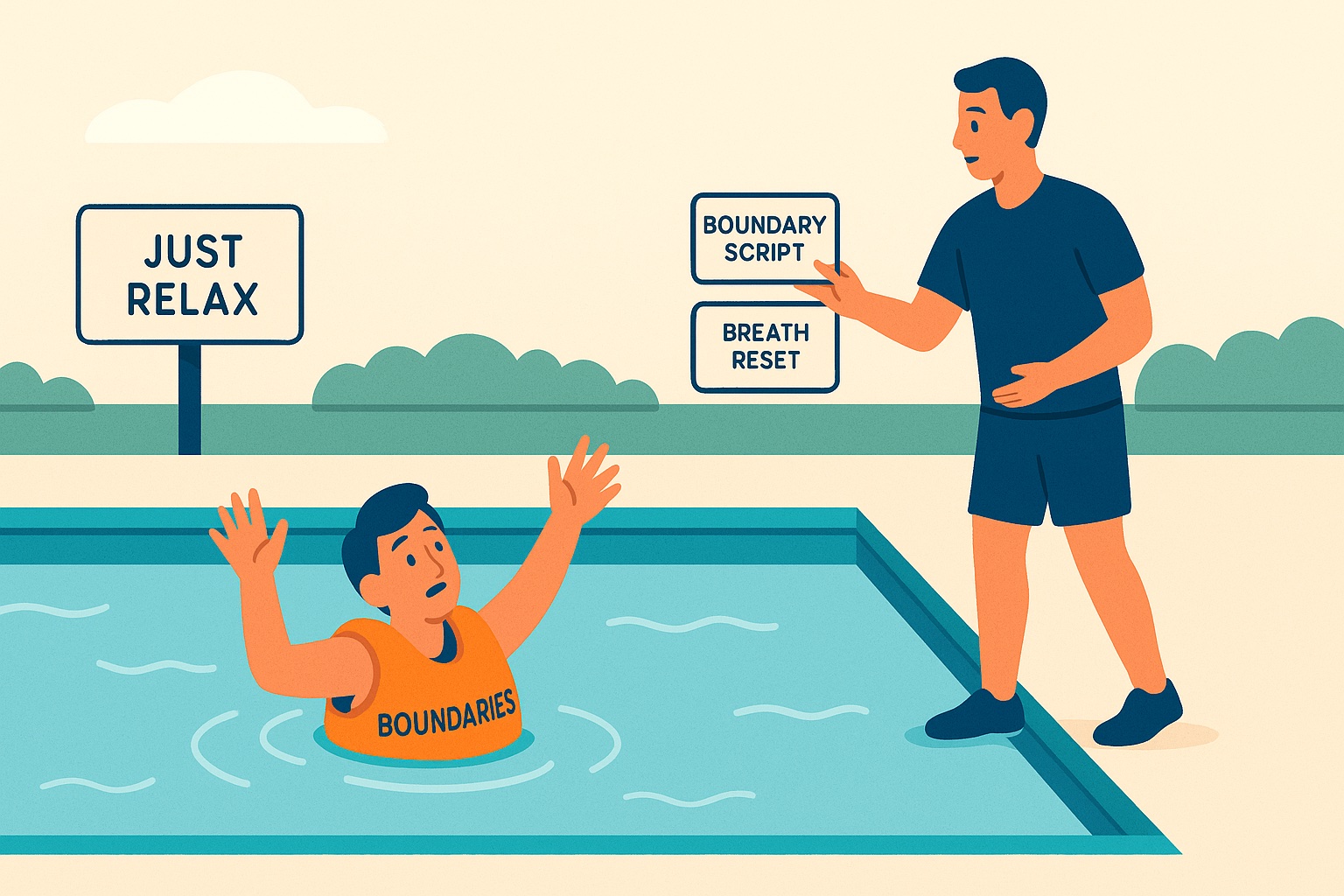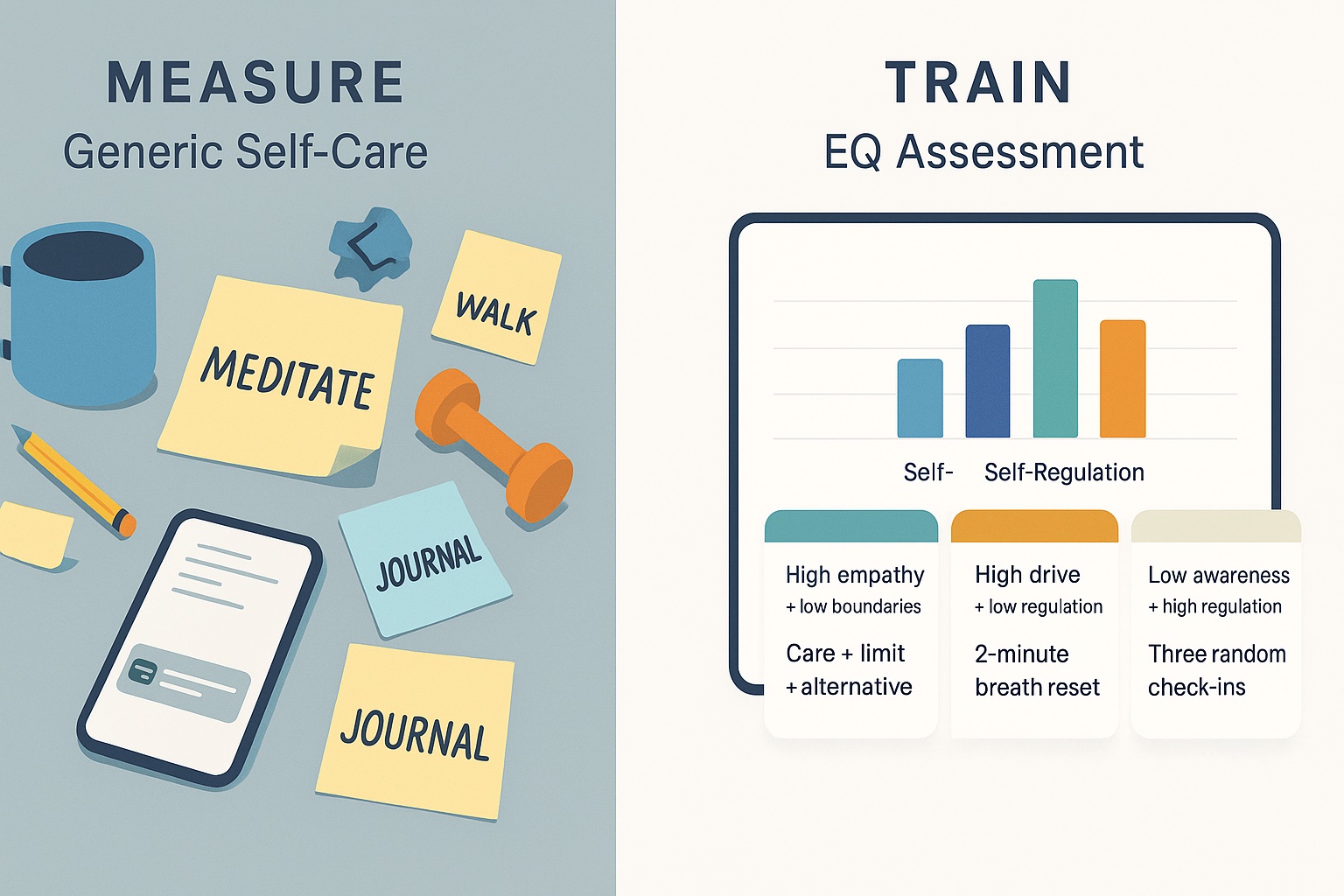How an Emotional Intelligence can beat Generic Self-Care

Stress Isn't the Enemy. Reactivity Is.
It's 10:47 pm. You're already in bed when your phone lights up with an email from your manager. Just the subject line—"Quick question about tomorrow's presentation"—sends your heart rate climbing. You open it. Read it three times. Start mentally drafting replies. Check the clock: 11:14 pm. Your chance at decent sleep just evaporated.
The problem isn't the email. It's not even the stress of having a presentation tomorrow. The real problem is the untrained emotional response: the spike, the spiral, the inability to downshift when you need it most.
Here's the good news: you can train for calm the same way you'd train for anything else. But first, you need to know where you actually stand.
Why Generic Self-Care Fails
You've heard it a thousand times: meditate, journal, take walks, practice gratitude. These aren't bad ideas, they're just incomplete. Without understanding your specific emotional patterns, you're throwing darts in the dark.
Telling someone with high empathy and weak boundaries to "be more mindful" is like telling someone who can't swim to "just relax in the water." The advice isn't calibrated to the actual problem.

The principle that works: Baseline → targeted habits → measurable change.
An EQ assessment is your diagnostic. It shows which emotional skills are creating friction in your day so you can stop adding more self-care hours and start removing the spikes that drain you. It measures how you process internal signals, manage arousal, connect with others, and make decisions under pressure—then maps those patterns to specific habits that actually work for your profile.
Don't add hours. Remove spikes.
The 3 EQ Skills That Predict Calmer Days
1. Self-Awareness: Catching the Signal Early
This is your ability to notice tension in your jaw, the urge to interrupt, or the dread when you see a certain name in your inbox—before these feelings hijack your response.
One sign you're low: You realize you're angry only after you've sent the email.
Quick habit: Set three random alarms during your day. When they go off, name what you're feeling in one word. That's it. Anger, calm, anxious, bored. You're building the reflex to check in.
2. Self-Regulation: Downshifting on Demand
Once you notice you're activated, can you actually calm down? This is impulse control and the ability to pause before reacting.
One sign you're low: You say things in meetings you regret by afternoon.
Quick habit: Before responding to anything that triggers you, take two breaths where the exhale is longer than the inhale. This activates your parasympathetic nervous system and buys you three seconds to choose your response instead of defaulting to reflex.
3. Social Clarity: Understanding Without Losing Yourself
This is your ability to read others accurately and maintain relationships without burning out. High empathy without boundaries leads to exhaustion. Low empathy creates isolation.
One sign you're low: Conflicts surprise you, or people seem distant without explanation.
Quick habit: In your next tense conversation, summarize what the other person said before offering your perspective. "So what I'm hearing is..." This forces you to actually listen instead of planning your rebuttal—and it de-escalates the other person.
Baseline → Behavior: Your Profile Becomes Your Plan
Once you have your assessment results, look for your weakest link. That's where small changes create outsized results.
If you score high on awareness but low on regulation, all that awareness just means you notice yourself spiraling—you don't stop it. If you're strong on empathy but weak on boundaries, you'll burn out trying to help everyone.
Example pattern mappings:
EQ Pattern | Recommended Micro-Habit |
|---|---|
High empathy + low boundaries | Care + limit + alternative |
High drive + low regulation | 2-minute breath reset before hard tasks; make the exhale longer than the inhale |
Low awareness + high regulation | Three random check-ins daily: “What am I feeling right now?” |
High awareness + low decision-making | 10-minute decision timer; constrain input gathering |
Low empathy + high pressure | Summarize before solving: “Tell me what matters most to you here.” |
The pattern matters more than individual scores. Your strengths can compensate for weaknesses once you know how to deploy them.
Three 60-Second Drills You Can Use Today
1. Label + Longer Exhale
When tension rises, name the emotion in one word (frustrated, anxious, defensive), then exhale for six seconds. Naming interrupts the automatic response. The long exhale signals safety to your nervous system.
Trigger cue: Any time your shoulders tighten.
2. Three-Line Summary
Before responding to feedback or conflict, restate what you heard in three lines or less. This forces understanding before reaction and often de-escalates the other person.
Trigger cue: Any conversation where you feel defensive.
3. Exit Sentence
Pre-write a phrase that ends unproductive spirals: "Let's recap next steps and reconnect tomorrow" or "I want to think about this—can we schedule 20 minutes this week?" Having the script ready removes mental load when you're already activated.
Trigger cue: When a conversation hits 20 minutes with no progress.
Pro tip: Tie each drill to a cue you already have—calendar alerts, your first coffee, your commute. Piggyback on existing routines rather than building new ones.
From Trigger to Choice: Micro-Scripts for Hot Moments
When you're activated, your working memory shrinks. Having pre-built scripts means you don't have to think clearly when you're least able to.
Email Heat: Reflect → Clarify → Ask
You get an email that makes you want to fire back immediately. Use this instead:
"I want to make sure I understand your concern. It sounds like [summarize their point]. Is that right? What would a good resolution look like from your perspective?"
This buys you time, forces understanding, and shifts from combat to collaboration.
Personal Boundary: Care + Limit + Alternative
When you need to say no without burning a bridge:
"I really value [relationship/project]. I don't have capacity to [request] right now. What I can do is [smaller offering] or [timeline shift]."
This protects your capacity while maintaining the relationship.
Critical rule: If your heart rate is higher than your words per minute, pause. You're physiologically flooded. No script will work until you downshift. Take two minutes, then return.
Conflict Without Fallout: The Summarize-Before-You-Argue Method
Most conflicts escalate because both people are fighting to be understood, not to understand. When you feel misunderstood, your nervous system treats it as a threat.
The fix: stop trying to make your point. Start by proving you understand theirs.
Three steps:
-
Mirror the content. "So you're saying the deadline moved up without warning, and now you're underwater."
-
Validate the stake. "That makes sense—you planned your week around the original timeline."
-
Offer one perspective. "Here's what I'm working with: [your constraint]. How do we navigate both?"
Understanding is not agreement. You can fully grasp someone's position without endorsing it. That alone de-escalates.
Your 7-Day Starter Plan
Day 1: Take the Free EQ Assessment
Get your snapshot. Identify your strongest skill and your weakest. This is your baseline.
Days 2–6: One Weak Area + One Daily Drill
Choose the skill where you scored lowest. Pick one 60-second drill that addresses it. Do it daily, tied to an existing cue (coffee, lunch, commute).
Pick one micro-script for a situation you'll face this week. Write it down. Rehearse it once.
Day 7: Track Three Metrics
Notice patterns over the week:
- Time-to-calm after trigger: Is it shrinking?
- Sleep onset: How many nights did you fall asleep within 20 minutes?
- Conflicts resolved in one conversation: Did you loop for days, or close it out in one exchange?
If you want deeper personalization—customized routines, additional scripts tailored to your profile, and specific 30-day goals—unlock the full report.
Use Your emotional Intelligence → with pratical tools and exercices.
The Real Shift

You're already spending time being activated, ruminating, and recovering from conflicts. These drills take 60 seconds and replace hours of emotional cleanup. You're not adding time—you're reclaiming it.
Meditation is one tool. These are situational: breath work before a meeting, summarizing during conflict, exit sentences when stuck. They're tied to real moments, not aspirational morning routines.
And if you're wondering whether EQ is "soft"—sleep quality, decision speed, and conflict resolution time are all measurable. Teams with higher EQ ship faster with less rework. If it affects performance, it's foundational.
Measure First, Train Small
You can't improve calm without a baseline. Guessing wastes time. Generic advice wastes energy.
Start with the free assessment. See your snapshot. Train the one or two skills that will create the biggest shift. Track three simple metrics for two weeks.
Stress isn't going anywhere. But reactivity—the spikes, the spirals, the nights you can't sleep because of an email—that's trainable.
Take the Complete Emotional Intelligence Assessment →
Measure your calm. Train the skills that matter. Build the days you actually want.
Other Posts:
Why Self-Improvement Fails Without Understanding Your Personality Traits ›
‹ Extraversion vs. Introversion: What the Science Actually Says